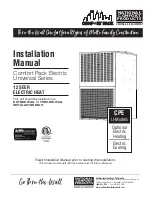
Spin Welder User’s Manual
Section 5 – Theory of Operation
Page 27
Page 26
Dukane Manual Part Number 403-547-03
Dukane Manual Part Number 403-547-03
Spin Welding Process
The formal definition of spin welding is “An as-
sembly process in which thermoplastic parts with
rotationally–symmetric mating surfaces are joined
together under pressure using unidirectional circular
motion. The heat generated during the rotational
contact melts the plastic in the heat–affected zone
forming a weld upon cooling” Note that the parts
do not have to be circular, only the mating surfaces
to be welded have to be circular.
The spin welding process is divided into 5 distinct
phases as shown in Figure 5–1. In Phase I, the rota-
tional friction generates heat. Frictional heating is
intensified with both axial pressure and joint surface
velocity. In Phase II, the friction results in abrasive
forces which strip off surface roughness, generating
wear particles causing the surfaces of the polymer
to begin to melt. As the polymer reaches its crystal-
line melting point or glass transition temperature, it
enters Phase III. This is an unsteady state in which
the temperature quickly increases and viscous flow
is initiated resulting in a large increase in melt thick-
ness. This is accompanied by a sharp rise in the
melt (weld) penetration velocity. Once the melting
process is initiated, heat is then generated by internal
friction within the molten region. This continues in
Phase IV until a steady state equilibrium is reached
and the penetration velocity stalls. In Phase IV,
the heat loss through the wall and flash expelled
approaches the heat being generated. Here the tem-
perature of the molten layer remains relatively con-
stant. Because plastics are poor conductors of heat,
the surface heat is transferred slowly to the interior
and much of it remains localized. At this point, the
rotation is stopped and we enter Phase V where the
molten material is allowed to cool under pressure
for a short period called the Hold Time.
Figure 5–1
Penetration Depth and Velocity as a
Function of Time During the Five Phases
of Spin Welding.
t
1
t
2
t
3
t
4
t
5
Weld
Penetration
Depth
Weld
Penetration
Velocity
I
II
III
IV
V
Frictional Heating
W
ear
Pa
rtic
les
Melting
Transition
Stead
y State
Hold
Time
















































